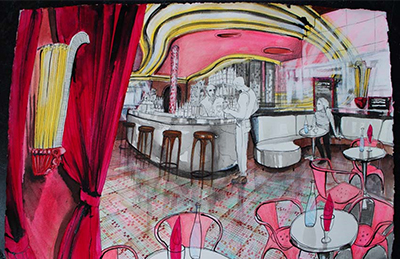
Artists both great and small often find themselves wandering the world, trying to find that place in the universe where they feel the truest version of their artistic self. What an artist yearns for is that perfect inspirational environment in which they can immerse themselves – enabling them to create something that uniquely reflects their thoughts, emotions and aspirations for their art.
The Cité Internationale des Arts in central Paris is one such place where artists from around the world congregate in search of the artist, dancer or musician within. Located on the river Seine, across from Notre-Dame Cathedral, the some 300 studio apartments provide residence solely for artists.
The perfect location then for NIDA Design Lecturer, Sue Field, to spend three months in the autumn/winter of 2015 on an awarded art residency by the University of New South Wales (UNSW). A trip that would culminate in the creation of four works of art that this week – over a year-and-a-half after they were first created – will be exhibited in Paris and published in a wonderful new book: An illustrated guide to Montmartre’s bars and cafes.
‘It’s a fun book,’ comments Sue as she prepares for her return to Paris for the exhibition and launch of the book, which are happening together at the Untitled Factory in Montmartre on Saturday 11 March. ‘It’s the practice part, the drawings, that is interesting rather than the writing part of the book.’
The idea for the book was conceived in the same place the drawings were, Montmartre – another one of those places that gifts artists with inspiration. During her residency in 2015, Sue joined with a group of artists in Montmartre to do some life drawings. And as well as the creation of numerous beautiful works of art, one member of the group had the idea of creating a book which would use the pictures as part of a guide for the area.
Almost a year passed without anything further said about the book. Then in late 2016, it was requested that Sue send the pictures she had done as part of the group life drawings work, because the book was finally beginning to take shape. Not only did this result in two of her pieces featuring in the book, but one was given the headline role of cover image.
The book itself is filled with stunning illustrations from Sue and 16 other artists – one of which just so happens to be 1996 Archibald Prize-winner Wendy Sharpe. Each illustration depicts a bar or café in Paris’ ‘artists quarter’, as the area is otherwise known, which is steeped in rich artistic history. Geniuses such as Pablo Picasso and Vincent van Gogh have had studios or had worked from the area.
Sue picked Café des Deux Moulins (the two windmills) for the subject matter of her illustrations. ‘I thought of all the beautiful cafes in Montmartre and that particular one came to mind instantly because it was in the film Amélie. It’s quite a famous French film featuring a gorgeous art deco café. It’s got about 20 pink chairs out the front and the most extraordinary art deco lamps inside from the 1920s and 1930s, as well as neon lights and incredible pink colours.’
The drawings themselves are mainly created from watercolour and ink. ‘I went to the café and sat there for a couple of hours drawing – from the inside and outside. Then I went back to my studio in Cite to draw them up.’
In addition to working as a full-time lecturer in NIDA’s Design for Performance department, Sue is also completing a PhD in creative practice at UNSW Art & Design. Her research aims to contribute new knowledge based on the development of a new genre of drawing underpinned by scenographic tropes, which can in turn add to our understanding of post-dramatic theatre and expanded drawing.

